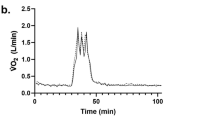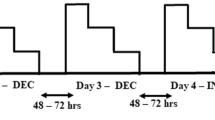Abstract
Mentally imaged but unexecuted physical activity has been reported to induce a cardiorespiratory change. In order to test whether the previous experience of the performed exercise was a prerequisite to observe these changes, ventilation and heart rate were recorded during mental imagination of a rowing race in four groups of volunteers: 12 competitive rowers, 10 non-rower athletes, 12 students (22–30 years old) and 12 senior subjects (50–60 years old). Recordings were performed at rest, during the viewing of a rowing race and during mental imagination of this race. Analysis of variance revealed significant condition effect for all cardiorespiratory variables. All subjects increased their breathing rate (mean increase: 16 breaths·min−1 in rowers, 8 breaths·min−1 in athletes, 8 breaths·min−1 in students, and 6 breaths·min−1 in seniors), 29 decreased their tidal volume (mean decrease: 100 ml in rowers, 102 ml in athletes, 120 ml in students and 26 ml in seniors), with an increase in the resulting ventilation in 38 subjects (mean increase: 14 l·min−1 in rowers, 3.6 l·min−1 in athletes, 2.8 l·min−1 in students, 2.6 l·min−1 in seniors). Heart rate was increased in 34 subjects (mean increase: 12 beats·min−1 in rowers, 5 beats·min−1 in athletes, 6 beats·min−1 in students and 5 beats·min−1 in seniors). The number of subjects who exhibited changes was evenly distributed among the four groups. However, mean values of the changes were higher in rowers than in the three other groups, mainly due to three rowers who exhibited extremely large increases in cardioventilatory variables. Analysis of variance showed no significant group effect for heart rate and breathing rate. These results suggest that rowing experience may not be necessary for changes in heart rate and ventilation to be elicited by mentally imagining a rowing race.


Similar content being viewed by others
References
Baldaro B, Battacchi MW, Trombini G, Polomba D, Stegagno L (1990) Effects of an emotional negative stimulus on the cardiac, electrogastrographic, and respiratory responses. Percept Mot Skills 71:647-655
Bouckaert J, Pannier JL, Vrijens J (1983) Cardiorespiratory response to bicycle and rowing ergometer exercise in oarsmen. Eur J Appl Physiol 51:51–59
Briggs SD, Raz N, Marks W (1999) Age-related deficits in generation and manipulation of mental images: I. The role of sensorimotor speed and working memory. Psychol Aging 14:427–435
Bruyer R, Scailquin JC (2000). Effects of aging on the generation of mental images. Exp Aging Res 26:337–351
Coe W, St Jean R, Burger J (1980) Hypnosis and the enhancement of visual imagery. Int J Clin Exp Hypn 28:225–243
Decety J, Jeannerod M, Germain M, Pastene J (1991) Vegetative response during imagined movement is proportional to mental effort. Behav Brain Res 42:1–5
Decety J, Jeannerod M, Durozard D, Baverel G (1993) Central activation of autonomic effectors during mental simulation of motor actions in man. J Physiol (Lond) 461:549–563
Fadiga L, Fogassi L, Pavesi G, Rizzolatti G (1995) Motor facilitation during action observation: a magnetic stimulation study. J Neurophysiol 73:2608–2611
Gallese V, Fadiga L, Fogassi L, Rizzolatti G (1996) Action recognition in the premotor cortex. Brain 119:593–609
Grafton ST, Arbib MA, Fadiga L, Rizzolatti G (1996) Localization of grasp representations in humans by positron emission tomography. 2. Observation compared with imagination. Exp Brain Res 112:103–111
Haas F, Distenfeld S, Axen K (1986) Effects of perceived musical rhythm on respiratory pattern. J Appl Physiol 61:1185–1191
Hagerman FC (1984) Applied physiology of rowing. Sports Med 1:303–326
Krogh A, Lindhard J (1913) The regulation of respiration and circulation during the initial stages of muscular work. J Physiol (Lond) 47:112–136
Ligett DR (2000) Enhancing imagery through hypnosis: a performance aid for athletes. Am J Clin Hypn 43:149–157
Maclennan SE, Silvestri GA, Ward J, Mahler DA (1991) Does entrained breathing improve the economy of rowing. Med Sci Sports Exerc 26:186–192
Mahler DA, Hunter B, Lentine T, Ward J (1991) Locomotor-respiratory coupling develops in novice female rowers with training. Med Sci Sports Exerc 23:1362–1366
Mahler DA, Shuhart CR, Brew E, Stukel TA (1994) Ventilatory responses and entrainment of breathing during rowing. Med Sci Sports Exerc 23:610–614
Morgan WP, Raven PB, Drinkwater BL, Horvarth SM (1973) Perceptual and metabolic responsivity to standard bicycle ergometry following various hypnotic suggestions. Int J Clin Exp Hypn 21:86–101
Paccalin C, Jeannerod M (2000) Changes in breathing observation of effortful actions. Brain Res 862:194–200
Raz N, Briggs SD, Marks W, Acker JD (1999) Age-related deficits in generation and manipulation of mental images : II. The role of dorsolateral prefontal cortex. Psychol Aging 14:436–444
Secher NH (1993) Physiological and biomechanical aspects of rowing. Implications for training. Sports Med 15:24–42
Steinacker JM, Both M, Whipp BJ (1993) Pulmonary mechanics and entrainment of respiration and stroke rate during rowing. Int J Sports Med 14:S15–S19
Szal SE, Schoene RB (1989) Ventilatory response to rowing and cycling in elite oarswomen. J Appl Physiol 67:264–269
Thornton JM, Guz A, Murphy K, Griffith AR, Pedersen DL, Kardos A, Leff A, Adams L, Casadei B, Paterson DJ (2001) Identification of higher brain centres that may encode the cardiorespiratory response to exercise in humans. J Physiol (Lond) 533:823–836
Wang Y, Morgan WP (1992) The effect of imagery perspectives on the psychophysiological responses to imagined exercise. Behav Brain Res 52:167–174
Wuyam B, Moosavi SH, Decety J, Adams L, Lansing RW, Guz A (1995) Imagination of dynamic exercise produced ventilatory responses which more apparent in competitive sportsmen. J Physiol (Lond) 482:713–724
Acknowledgement
We are grateful to Alain Waché, coach of the Rowing club of Grenoble, for his help in the completion of this study.
Author information
Authors and Affiliations
Corresponding author
Rights and permissions
About this article
Cite this article
Calabrese, P., Messonnier, L., Bijaoui, E. et al. Cardioventilatory changes induced by mentally imaged rowing. Eur J Appl Physiol 91, 160–166 (2004). https://doi.org/10.1007/s00421-003-0929-9
Accepted:
Published:
Issue Date:
DOI: https://doi.org/10.1007/s00421-003-0929-9




